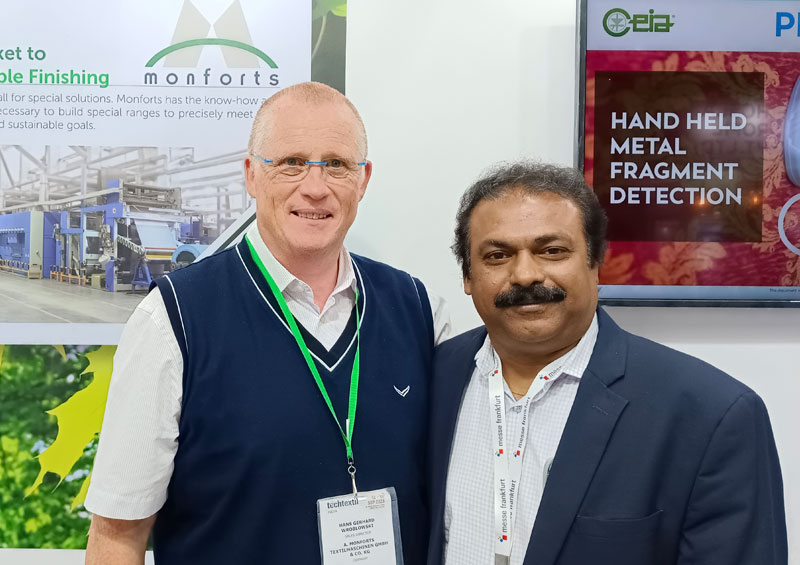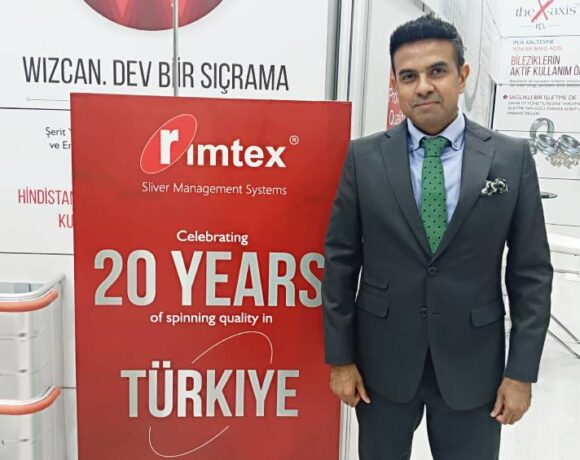Innovation In Textile Industry Is Being Driven By Digitalization, Sustainability And Other Factors

Digitalization has become a necessity because every aspect of textile industry’s operations requires thorough documentation, says S. Rajendran of A.T.E. Enterprises Pvt. Ltd., while Hans Wroblowski of A. Monforts Textilmaschinen GmbH & Co. KG adds that automation is less about being state-of-the-art and more about data processing required to empower individuals. In an exclusive interview with Henry Dsouza of Textile Insights, these experts shed light on the crucial role of digitalization and automation in shaping the future of the textile industry.
How has automation and digitalization impacted efficiency and productivity in textile processing machines?
Rajendran: Nowadays, there is a strong emphasis on automation and digitalization in the textile industry, and these two concepts are closely intertwined. Firstly, process automation has gained significant attention. It is primarily aimed at ensuring consistent quality and boosting productivity. Digitalization has become a necessity because every aspect of our operations requires thorough documentation, which translates into data analysis being indispensable for conducting business successfully.
In India, there has been a notable increase in awareness surrounding these technologies, with discussions and initiatives gaining momentum. At A.T.E. Group, we recognized the potential of automation and digitalization a few years ago and our efforts have yielded considerable success. For instance, in the realm of process automation, we have established partnerships with leading companies like Color Service s.r.l. of Italy, which provides comprehensive solutions for colour and chemical storage and dispensing. We have also collaborated with Craftsman Automation Limited of Coimbatore, which specializes in solutions for automated warehousing, storage and retrieval systems. Additionally, TEXPA Maschinenbau GmbH & Co. KG, a German company, offers a comprehensive package of machinery for cutting, hemming, folding and packing home textiles.
It is noteworthy that all our partners are actively incorporating digitalization features into their machines, reflecting the evolving demands of the industry.
Hans: To elaborate further, it’s not a matter of when to begin discussing digitalization; this type of automation has been an ongoing process. For us, it’s less about automation being state-of-the-art and more about the data processing required to empower individuals with greater knowledge and information for quality control. The primary challenge is to ensure quality control and a swift response to market demands, including direct engagement with customers online.
Today, data exchange through the internet and cloud systems is becoming increasingly prevalent. The transition to Enterprise Resource Planning (ERP) systems has long been established and new systems are incorporating intelligent technologies, which will continue to be integrated in the future. In general, automation and digitalization have been evolving over the past two decades and this evolution is gaining momentum. The issue lies in the fact that people are not fully utilizing the capabilities of machines that are already equipped with advanced features.
People often underutilize these capabilities because they lack knowledge of how to harness them effectively. This includes generating graphs for quality control, implementing sensors, optimizing machine speeds and controlling dwell times to reduce errors. Each aspect has already made its way into the market, and it is considered standard practice for us to have these systems in place. We are currently fine-tuning data transmission for cloud systems, incorporating computational elements and working on establishing robust machine learning systems. The goal is to provide quicker feedback and enhance overall productivity.
This journey has been ongoing for several years and I believe that as the industry becomes more comfortable with the use of cloud and internet systems allowing data transmission to international suppliers, we will start to reap the benefits. Up until now, there has been reluctance to share data over the internet due to security concerns. The industry needs to overcome this mindset. As it does, digitalization will become more widespread and the positive impact will become even more apparent.
How do you see sustainable finishing evolving?
Hans: First, let me address the term “sustainable solutions.” It seems that many people may not fully grasp the essence of sustainable solutions or the true meaning of sustainability. To begin with, energy conservation has been a focus for over 40 years, with everyone striving to reduce water consumption and production costs. People often inquire about how to minimize water usage and optimize parameter settings which, in my view, are part of a sustainable solution.
Throughout my career in India and internationally, sustainable finishing has been a guiding principle. The core concept revolves around achieving the same results with less humidity and the same amount of chemicals. This means achieving equivalent outcomes while using less water content, ultimately leading to reduced energy consumption. Machines can operate more efficiently, resulting in increased productivity. Every aspect of this process contributes to sustainable solutions.
However, the key challenge lies in implementing the right system to minimize water and chemical usage, without overusing what is necessary. That, to me, is the essence of sustainable solutions. On the subject of sustainability, I’m perplexed by the notion of petrochemical fibres as sustainable solution. It would be helpful for the industry to clarify where sustainability comes into play, considering that the production of petrochemical fibres is not typically considered sustainable. Nonetheless, we require such products and must explore ways to mitigate their environmental impact, such as using chemicals that reduce their environmental footprint.
In the future, we anticipate the emergence of recycled products and natural fibres. Many are considering chemical modifications of cotton or even transforming general cellulose into properties resembling polyester, which could be integrated into extra fibre bases. These developments are expected to gain traction in the coming years. In this context, Monforts is actively working alongside partners, including the automotive industry, which seeks to reduce its reliance on petrochemical fibres and explore alternative fibre materials.
As you can see, sustainable solutions encompass various aspects, from research and fibre development to the machinery used in production. The focus is on achieving more with less, without compromising on quality or performance.
What trends can we anticipate in textile processing machinery for the technical textile industry in the near future?
Rajendran: The technical textile sector in India is experiencing significant growth. The demand for technical textiles, both domestically and globally, is on the rise. In India, we have local producers catering to our domestic market as well as international clients. Looking at the Indian scenario, the construction industry and infrastructure development are booming, creating a substantial need for technical textiles. Geotextiles, in particular, are playing a crucial role in infrastructure projects and are expected to witness increasing demand.
Another emerging trend is sportech textiles. Modern consumers, especially the youth, are gravitating towards sports clothing for its comfort and performance-enhancing qualities. This segment is witnessing substantial growth in terms of consumption. Additionally, there’s a positive outlook in India due to increasing investments in synthetic materials.
The third noteworthy trend is medical textiles. The awareness of the importance of sanitation and hygiene, especially in the wake of the Covid-19 pandemic, has surged. This has led to a growing demand for medical textiles and we anticipate this industry to continue expanding.
In summary, the technical textile industry in India holds significant growth potential. A.T.E. Group is well-positioned to provide a comprehensive range of machinery for various segments within the technical textile sector, supporting this promising growth trajectory.
Can the sale of Monfort’s Montex® Coat machine to Vietnamese company Thai Tuan at ITMA Milan be seen as an indication of the adoption of advanced textile technology in emerging markets?
Hans: It’s a complex question because coating machines are prevalent across various industries, including emergency materials and clothing. In the case of Vietnam, the interest in this machine primarily revolves around active wear. As Rajendran mentioned earlier, Sportech is a growing trend, driven by the need for cost-effective applications that use precisely what’s necessary.
The Montex®Coat machine is a new addition designed to provide optimal solutions for the emergency segments. Various factors come into play, such as the choice of chemistry required to achieve specific effects. This necessitates optimization, whether through foam, stable solutions or paste-form applications. The method of application, whether rotary or by a knife over air, depends on the desired end product properties. This field requires in-depth discussions with experts to tailor the equipment to the specific coating requirements. It’s crucial to understand the desired effects, breathability, fire retardancy and protection, among other factors, to fine-tune the machinery.
I’d like to emphasize that Monforts has received significant interest, not only during ITMA Milan but even before, resulting in machine placements in this field. However, it’s essential to acknowledge the substantial investment of time and effort required to engage with customers, ensure chemistry expertise is available and collaborate with individuals experienced in this type of processing. These efforts are crucial to streamline the entire production process effectively.
What, in your view, are the primary drivers of innovation in the textile finishing industry and how does Monforts fit into this evolving landscape?
Rajendran: Innovation in the textile industry is being driven by several factors, including digitalization and sustainability. Monforts has made significant strides in this regard. One notable innovation is our Eontrol® dyeing technology, developed in collaboration with Dystar. It has gained widespread acceptance in the Indian market for reactive dyeing. Unlike conventional methods that require substantial salt and urea, our technology eliminates the need for these additives, making the process more sustainable. Additionally, it dramatically reduces dyeing time. While conventional methods may take 10 to 12 hours, our technology completes the process in just three minutes. We’ve already sold over 60 ranges in India, and the feedback from customers has been highly positive. We are now introducing this technology to the mid-segment market, which is growing in India. Furthermore, Monforts is working on condensation lines for preparation, which is an emerging need in the market.
Hans: Additionally, we’ve applied the same technology to yarn dyeing, expanding our reach to the denim industry for multicolour and indigo light and medium shades. We’ve also developed a complete Ecobleach system that combines bleaching and dyeing processes without the need for intermediate washing, reducing water and energy consumption.
While introducing new innovations is exciting, it’s important to acknowledge that it takes time for the industry to adopt them. Customers seek proof and trust in these innovations and collaboration with customers is essential to ensure their successful implementation.
We’re also focusing on energy efficiency and sustainable energy sources. Hydrogen as an energy source, combined with solar installations, is gaining attention. Many Indian companies are investing in solar installations to generate their own green energy. The hydrogen production process should also rely on green power sources for a truly sustainable approach. It’s an evolving field with great potential.
Lastly, air cleaning technology is crucial for sustainability. In India, there’s a significant focus on synthetic fibres and these often contain oil residues that need to be removed before dyeing. Air cleaning solutions, such as electro filters and UV lamps, can ensure the air released is nearly 100% clean. Creating awareness and implementing such solutions is essential for environmental sustainability.
Rajendran: I’d like to emphasize the importance of air cleaning. In India, many textile processors do not pre-wash fabrics, which results in oil residues in synthetic and lycra fibres. When these fabrics are heat-set without pre-washing, the oil evaporates and pollutes the air. Monforts offers solutions to clean the air in stenter machines and creating awareness about this sustainability aspect is vital in the Indian textile industry.
How has the response been at Techtextil India 2023 for both of you?
Hans: To be honest, the response has been fantastic. We’ve seen a genuine interest in exploring new solutions, some of which attendees had never encountered before. They’ve engaged in discussions about various aspects, not limited to just coating but also focusing on sustainability and finishing processes. What’s particularly noteworthy is the depth of interest and engagement from the attendees. They’ve absorbed the information we’ve shared, and it’s clear that they are genuinely eager to learn. In my view, the response to this exhibition has been fantastic.
Rajendran: I completely concur with Hans. The response has been highly positive. One interesting observation is that, traditionally, the machinery producers attend Techtextill to discuss with the existing technical textile producers for expanding their production or introducing their new offerings. However, this time around, we’ve seen many conventional textile producers in attendance. They are keen to learn about technical textiles and are considering venturing into this domain, seeking ways to enhance their capabilities and add value. We’ve also had the opportunity to engage with existing customers who have traditionally focused on conventional textiles, and this signals a clear indication of the potential for growth in the technical textiles sector in India. We are very optimistic about the prospects ahead.















